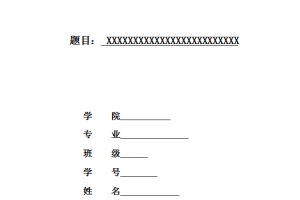摘要
目前对资产评估理论的研究基本上都局限于在现行资产评估理论框架下的个别问题的探讨,评估界存在对资产评估理论中价格、价值,评估计价标准等基本概念的讨论,但讨论主要从实用角度出发,少有从资产评估理论的本质出发进行分析的;评估界也存在对资产评估方法的讨论,但讨论多仅限于单一资产评估时方法应用本身,没有将方法在各类资产评估时的应用对应起来进行比较、统一。
资产评估方法可以归纳为三种,即国际上公认的三大评估方法:成本法、收益法和市场法。对形态各异、种类繁多的资产实施评估,选择评估方法总是有侧重和优选顺序的。学习资产评估的方法,不但要全面掌握每一条资产评估途径及方法的内涵、技术要求、适用条件,而且还要全面掌握各个评估途径之间的内在逻辑关系,以及配合适用要领等。本文以资产评估方法在房地产企业中的应用为研究主题,进一步研究资产评估在企业中的运用,为以后相关研究提供参考。
Abstract
At present, the basically are limited to the evaluation of individual issues within the framework of the theory in the current assets of assets evaluation theory, there are the price of assets evaluation, value theory, discusses the basic concept of valuation standards, but the discussion mainly from the practical angle, little from the theory of assets appraisal essence analysis; there are also discussed on the assets evaluation method for the assessment of world, but much of the discussion is limited to a single asset assessment method itself, not in all kinds of assets evaluation application corresponding comparative, unity.
Method can be classified into three types of assets evaluation, three evaluation methods that is internationally recognized: cost method, income method and market method. The implementation of assessment of different forms, different kinds of assets, the choice of assessment method is always a focus and priority. Method study of asset evaluation, not only to grasp every asset evaluation method and content, technical requirements, applicable conditions, but also to fully grasp the internal logical relationship between the various evaluation methods, as well as with applicable methods etc.. In this paper, the assets assessment method is applied in the real estate enterprises as the research subject, further evaluation of assets in enterprise applications, and provide reference for future research.
Keywords: real estate enterprise assets evaluation
目 录
摘要………………………………………………………………………………………………………………………………………………. 2
Abstract…………………………………………………………………………………………………………………………………………. 3
1综述……………………………………………………………………………………………………………………………………………. 5
HYPERLINK \l _Toc14678 1.1本文的研究背景……………………………………………………………………… 5
1.2本文的研究意义………………………………………………………………………….. 6
HYPERLINK \l _Toc26856 1.3.1国外的研究现状………………………. 7
HYPERLINK \l _Toc31815 1.3.2我国的研究现状………………………. 7
2.1 收益现值法…………………………………………………………………………………………………………………………… 8
2.1.1收益现值法的定义及评估过程………………………………………………………………………………………… 8
2.1.2收益现值法的优缺点………………………………………………………………………………………………………… 9
2.2 重置成本法…………………………………………………………………………………………………………………………. 10
2.2.1重置成本法的定义及评估过程……………………………………………………………………………………… 10
2.2.2重置成本法的优缺点………………………………………………………………………………………………………. 11
2.3 现行市价法…………………………………………………………………………………………………………………………. 11
2.3.1现行市价法的定义及评估过程………………………………………………………………………………………. 11
2.4市场比较法………………………………………………………………………………………………………………………….. 12
2.5剩余法………………………………………………………………………………………………………………………………….. 13
2.6假设开发法………………………………………………………………………………………………………………………….. 13
2.7基准地价法………………………………………………………………………………………………………………………….. 14
3.资产评估方法在国企中的运用……………………………………………………………………………………………. 15
3.1成本法、市场法以及收益法的应用………………………………………………………………………………… 15
3.2成本法的应用价值……………………………………………………………………………………………………………… 15
4.资产评估方法存在的问题……………………………………………………………………………………………………. 16
4.1商誉的评估方法存在的问题…………………………………………………………………………………………….. 16
4.2人力资源评估方法存在的问题…………………………………………………………………………………………. 16
4.3房地产资产评估暴露出来的问题…………………………………………………………………………………….. 17
4.4以商标为主要形式的房地产资产评估出现问题……………………………………………………………. 17
4.5按房地产资产成本进行评估存在的问题………………………………………………………………………… 18
4.6 房地产评估机构业务范围不明确引发的问题………………………………………………………………… 19
4.7资产评估方法在房地产中的应用…………………………………………………………………………………….. 19
5 改善房地产资产评估方法存在的问题的措施…………………………………………………………………… 20
5.1 综合应用各种房地产资产评估方法………………………………………………………………………………. 20
5.2 完善和改进收益法……………………………………………………………………………………………………………… 21
5.3 充分发挥技术路线的作用…………………………………………………………………………………………………. 21
5.3.1 房地产评估技术路线与房地产评估方法的密切关系………………………………………………… 22
5.3.2 把握房地产评估技术路线有助于正确运用房地产评估方法……………………………………. 23
5.4 完善市场运行和监管规则…………………………………………………………………………………………………. 23
5.5 培养复合型人才………………………………………………………………………………………………………………….. 24
5.6 建立健全房地产评估相关法律法规………………………………………………………………………………… 24
总结…………………………………………………………………………………………………………………………………………….. 25
参考文献……………………………………………………………………………………………………………………………………. 26
致谢…………………………………………………………………………………………………………………………………………….. 28





